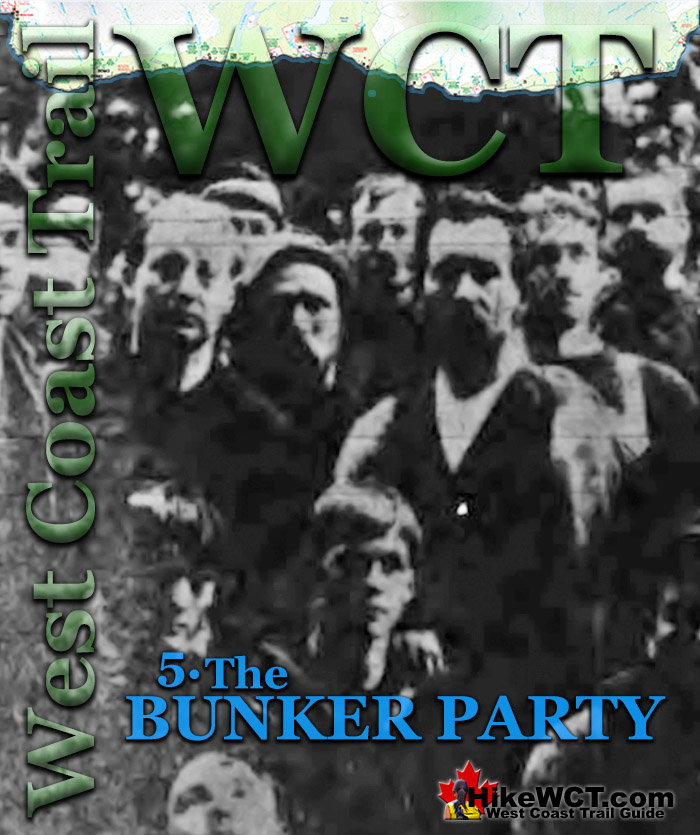![]() All but one of the seven lifeboats were launched during the first hour of the Valencia disaster, between midnight and 1am, Tuesday, January 23rd, 1906. Of the estimated sixty passengers and crew that boarded these six boats, only nine would live to tell about it. It is not known how many woman and children were on those boats, probably more than half, all were lost. One of the nine survivors, passenger Frank Bunker, recalled the events as the Valencia shipwreck turned into a disaster.
All but one of the seven lifeboats were launched during the first hour of the Valencia disaster, between midnight and 1am, Tuesday, January 23rd, 1906. Of the estimated sixty passengers and crew that boarded these six boats, only nine would live to tell about it. It is not known how many woman and children were on those boats, probably more than half, all were lost. One of the nine survivors, passenger Frank Bunker, recalled the events as the Valencia shipwreck turned into a disaster.
The Valencia Disaster
![]() 1. The Valencia
1. The Valencia ![]() 2. The Voyage
2. The Voyage ![]() 3. The Boats
3. The Boats ![]() 4. The McCarthy Boat
4. The McCarthy Boat ![]() 5. The Bunker Party
5. The Bunker Party ![]() 6. On the Valencia
6. On the Valencia ![]() 7. The Rafts
7. The Rafts ![]() 8. The Turret Raft
8. The Turret Raft ![]() 9. The Rescue Ships
9. The Rescue Ships ![]() 10. The Aftermath
10. The Aftermath ![]() 11. The Survivors
11. The Survivors ![]() 12. The Lost
12. The Lost
The West Coast Trail
![]() Prologue 1: The West Coast Trail
Prologue 1: The West Coast Trail ![]() 2: When to Hike & Fees
2: When to Hike & Fees ![]() 3: Trailheads
3: Trailheads ![]() 4: Getting There
4: Getting There ![]() 5: Considerations
5: Considerations ![]() 6: Campsites
6: Campsites ![]() 7: Shipwrecks
7: Shipwrecks ![]() 8: Routes
8: Routes ![]() 9: Sights & Highlights
9: Sights & Highlights
“When the Valencia went on the rocks, instantly all was confusion. Crew and passengers ran wildly to and fro and the air was full of orders to lower boats. I do not know whether all the orders were issued by officers or not. Everybody seemed bent on taking care of themselves.” Bunker boarded lifeboat No.6 with his wife, 4-year-old daughter Dorothy, and 2-year-old son also named Frank. With them on the boat were four other passengers and two firemen from the crew of the Valencia, Frank Richley and a Greek fireman whose name was not known. In horrific stormy conditions at night with sleet and rain falling, boat No.6 was lowered successfully into the maelstrom of crashing ocean that surrounded the Valencia. Frank Richley recalled later that he and the other fireman were the only people that knew how to handle a boat. They managed to row a couple hundred yards from the Valencia before being caught by a breaker and capsized into the freezing ocean. Richley, Bunker, his wife and son managed to survive, though his daughter Dorothy, the Greek fireman and four passengers disappeared under the boiling surf. The half-submerged boat righted and Frank Bunker holding his son, managed to climb back in along with his wife who did the same. Frank Richley was the last to get back into the boat, pulled in by Frank Bunker. For a couple terrifying minutes, the boat rose and fell as massive waves rolled under them. Suddenly a huge wave picked them up and threw them against the rocky shore, smashing the boat to pieces. Bunker and Richley were hurled ashore and despite the powerful undertow pulling them back out several times, they both survived. Bunker managed to claw his way above the crashing waves first. Stumbling in the darkness he got as far as he could from the breaking waves, which was just a few metres away at the bottom of a hundred-foot cliff. He heard shouts from others and discovered other survivors had reached shore from another boat. Soon Frank Richley found them as well and exhausted, the nine survivors huddled together against the cliff in darkness, soaking wet, freezing cold and miraculously still alive. Bunker’s wife, two children, or any of the others from boat No.6 were ever seen again. Bunker and Richley survived from lifeboat No.6 and the seven other men they found gathered at the cliffs came from lifeboat No.3 in very similar circumstances.
Valencia's Port Side Lifeboats
Valencia's port side lifeboats No.2, No.4 and No.6 are shown in this photo. Bunker and Richley were on the No.6 boat near the aft end of the ship on the port side. The No.1, No.3 and No.5 boats are not visible on the starboard side, directly opposite the port side boats. The boat next to the No.6 boat, labelled No.7 was the small working boat.
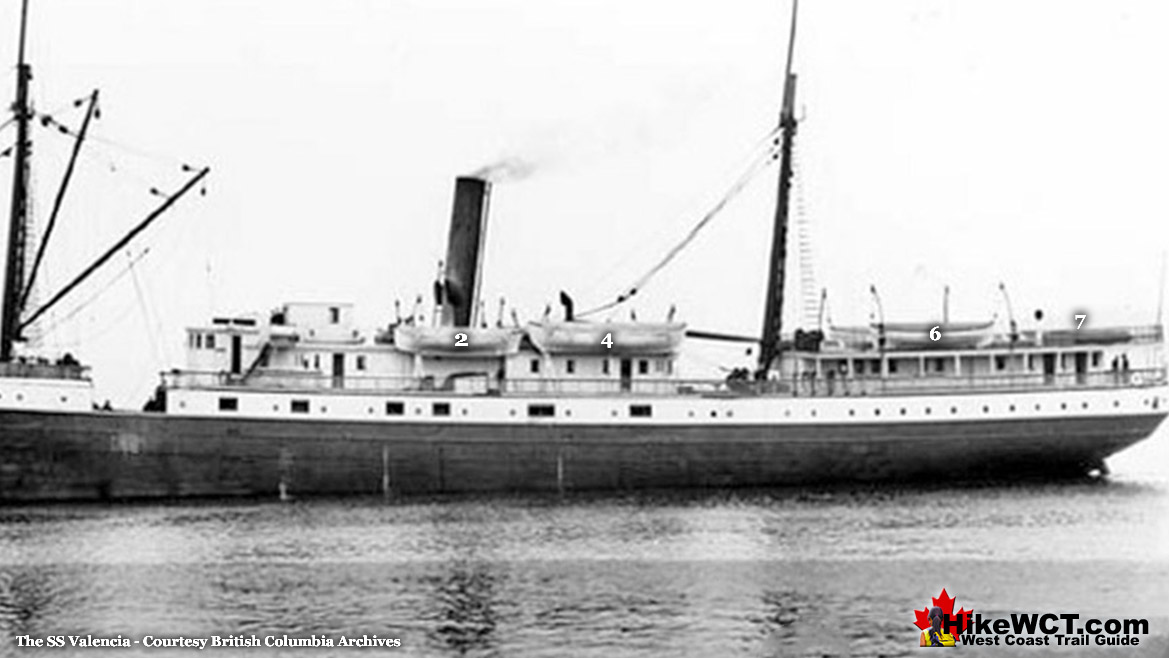
Brutal Coastline Cliffs Survivors Faced
This is a recent picture of the brutal coastline cliffs probably similar to what Bunker, Richley and the others faced. There is no record of the precise location they washed ashore, though we do know that it was along the coast in the vicinity of these cliffs. To get an idea of what these lifeboat survivors faced, you have to picture huge waves crashing over that flat triangle of solid rock jutting out into the ocean. Bunker and Richley somehow managed to hold on to the slippery, flat rock shelf against the powerful undertow repeatedly sucking them back out. When you hike along the West Coast Trail on broad and flat rock shelves like this you usually find them wet, slimy and incredibly slippery. They somehow held on and survived this in the dark, on a cold winter night with sleet and rain falling. And for Frank Bunker and Frank Campbell, having just lost their families moments before. What a terrifying and agonizing place to end up, trapped against a cliff, in the dark, wet and freezing cold.
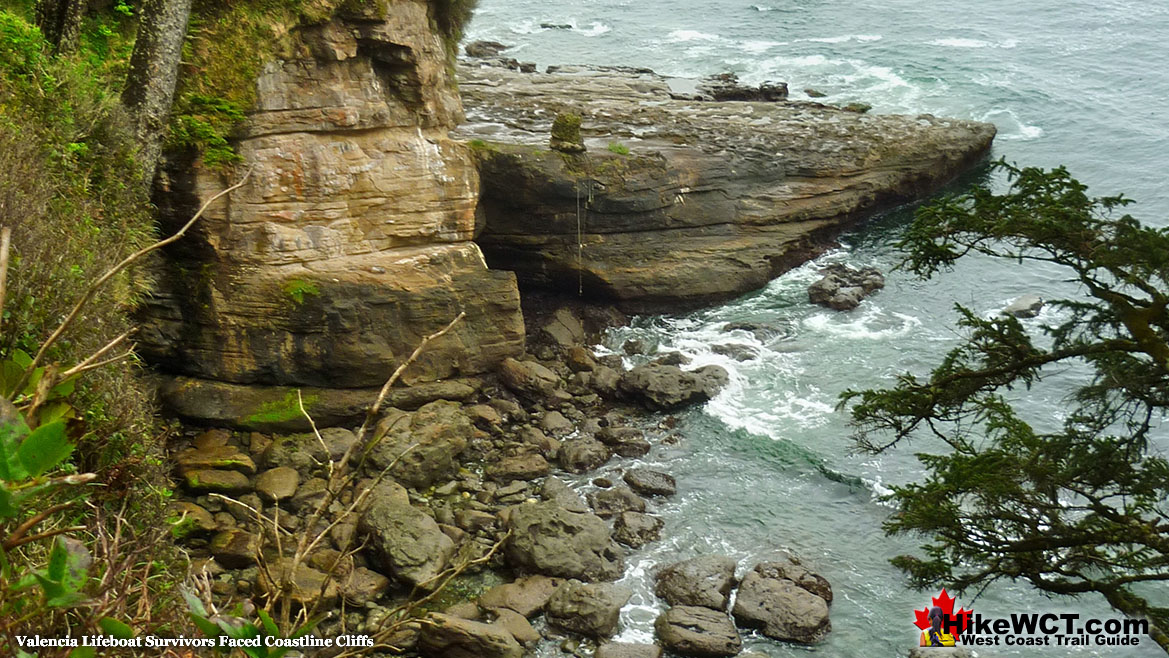
Valencia Lifeboat No.3 Successfully Launched
 Valencia passenger Frank Campbell was on boat No.3 with his wife and 16-year-old stepdaughter. Though No.3 was the largest lifeboat the Valencia had, it was lowered only half full, with only about 15 people on board. With sleet and rain falling, they struggled to get the four oars in place and Campbell’s stepdaughter noticed water filling the boat. The plug hole in the bottom of the boat was open and water was pouring through. They scrambled in the dark to find the plug and it appeared to be missing from this boat. Albert Willis, a 17-year-old American sailor, heading for Seattle to report for duty on the battleship Philadelphia put his hand over the hole and stopped the freezing water from pouring in. He kept his hand over the hole, despite the painful cold for several minutes, as they to rowed away from the starboard side of Valencia and into the darkness. It was during these first minutes of rowing away from the Valencia that Campbell realized that he was on a boat with people that knew nothing of seamanship. They managed to row about two or three hundred metres despite the wooden oarlocks breaking which made the oars clumsy and hard to use. Moments later one of the oars was lost and the boat veered towards the surf crashing violently into shore hidden in darkness. Campbell recalled thinking that the shore was close, and they just needed to ride through the surf to get there.
Valencia passenger Frank Campbell was on boat No.3 with his wife and 16-year-old stepdaughter. Though No.3 was the largest lifeboat the Valencia had, it was lowered only half full, with only about 15 people on board. With sleet and rain falling, they struggled to get the four oars in place and Campbell’s stepdaughter noticed water filling the boat. The plug hole in the bottom of the boat was open and water was pouring through. They scrambled in the dark to find the plug and it appeared to be missing from this boat. Albert Willis, a 17-year-old American sailor, heading for Seattle to report for duty on the battleship Philadelphia put his hand over the hole and stopped the freezing water from pouring in. He kept his hand over the hole, despite the painful cold for several minutes, as they to rowed away from the starboard side of Valencia and into the darkness. It was during these first minutes of rowing away from the Valencia that Campbell realized that he was on a boat with people that knew nothing of seamanship. They managed to row about two or three hundred metres despite the wooden oarlocks breaking which made the oars clumsy and hard to use. Moments later one of the oars was lost and the boat veered towards the surf crashing violently into shore hidden in darkness. Campbell recalled thinking that the shore was close, and they just needed to ride through the surf to get there.
Frank Campbell and Albert Willis Remember
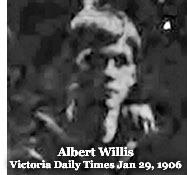 What he didn’t know was the shore was a jagged, solid rock shelf with massive waves crashing over it. The surf smashed the boat against this shelf of rock and everyone on board was thrown into the crashing sea. Campbell remembers falling out one side of the boat and his wife and daughter out the other. He never saw them again. He found himself clinging to an oar and being pulled out by the undertow of an enormous breaker coming in. Suddenly someone grabbed him, desperately trying to save himself. Campbell shouted to him to take part of the oar as the breaker lifted them up and threw them onto the reef. The tremendously powerful undertow was pulling them back out and Campbell grasped a crevice with all his strength. He felt at that moment that if he let go, he would be dead. He remembered that terrifying moment of struggle to hang on while the other man was pulled out and never returned. In the seconds before the next breaker would crash down, Campbell crawled up the solid rock shore beyond the breakers and collapsed to the ground. Albert Willis also survived and remembered being thrown to the shore and pulled back into the ocean three times. He never found anything to grasp onto, or the strength to hang on. The fourth time the undertow dragged him back out, his pants snagged on a rock and possibly saved his life. He used the few seconds before the next wave came crashing down to scramble up to safety.
What he didn’t know was the shore was a jagged, solid rock shelf with massive waves crashing over it. The surf smashed the boat against this shelf of rock and everyone on board was thrown into the crashing sea. Campbell remembers falling out one side of the boat and his wife and daughter out the other. He never saw them again. He found himself clinging to an oar and being pulled out by the undertow of an enormous breaker coming in. Suddenly someone grabbed him, desperately trying to save himself. Campbell shouted to him to take part of the oar as the breaker lifted them up and threw them onto the reef. The tremendously powerful undertow was pulling them back out and Campbell grasped a crevice with all his strength. He felt at that moment that if he let go, he would be dead. He remembered that terrifying moment of struggle to hang on while the other man was pulled out and never returned. In the seconds before the next breaker would crash down, Campbell crawled up the solid rock shore beyond the breakers and collapsed to the ground. Albert Willis also survived and remembered being thrown to the shore and pulled back into the ocean three times. He never found anything to grasp onto, or the strength to hang on. The fourth time the undertow dragged him back out, his pants snagged on a rock and possibly saved his life. He used the few seconds before the next wave came crashing down to scramble up to safety.
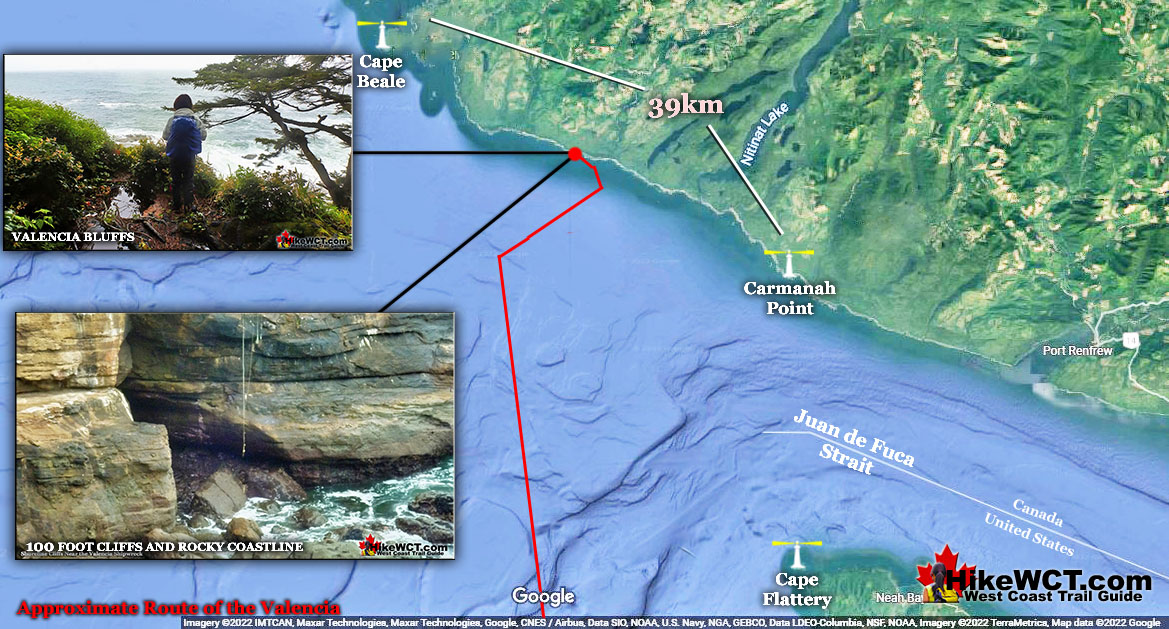
1am Tues, 23 Jan: Huddled Against the Cliff Until Dawn
Somehow Campbell, Willis and five other men survived from lifeboat No.3 and ended up finding each other along the shore at the base of near vertical cliffs probably about 300 metres up the coast from the Valencia. The five other survivors from boat No.3 were Tony Brown, George Billikos, Yosuki Hosoda, Mike Stone and Charles Samuels. Among the drowned were the wife and stepdaughter of Frank Campbell. These seven men along with Frank Bunker and Frank Richley from the No.6 lifeboat huddled together under the freezing rain at the base of a hundred-foot cliff. Frank Bunker later recalled that the time was about 1am on Tuesday, January 23rd. They had survived the boats, now freezing cold and wet, they had to get through the night trapped in the dark at the bottom of a cliff.
Morning Tues, 23 Jan: Difficulties Ahead
The Valencia wrecked near KM18 of what would eventually be the West Coast Trail, was built in the years following the Valencia disaster. In 1906, nearly all of what is today the West Coast Trail, was at that time along an unmarked route through rainforest generally characterized as impenetrable. The difficulty of hiking through the forest along the West Coast of Vancouver Island at the time of the Valencia disaster was nearly impossible to comprehend. A single kilometre could take hours to hike through and with no trail to follow and surrounded by walls of forest, there is no way to know if the direction you are hiking leads anywhere. This is the forest the Bunker Party first entered after spending the night wet and freezing. Some of the party had lost their shoes and set out into the forest through ankle deep snow. Frank Richley had badly injured his ankle and had difficulty walking. Not only were the group battered and weakened from surviving the night, but they also assumed that they were south of Cape Flattery, along the mainland coast of the United States. This would influence their actions considerably when they started out in the morning.
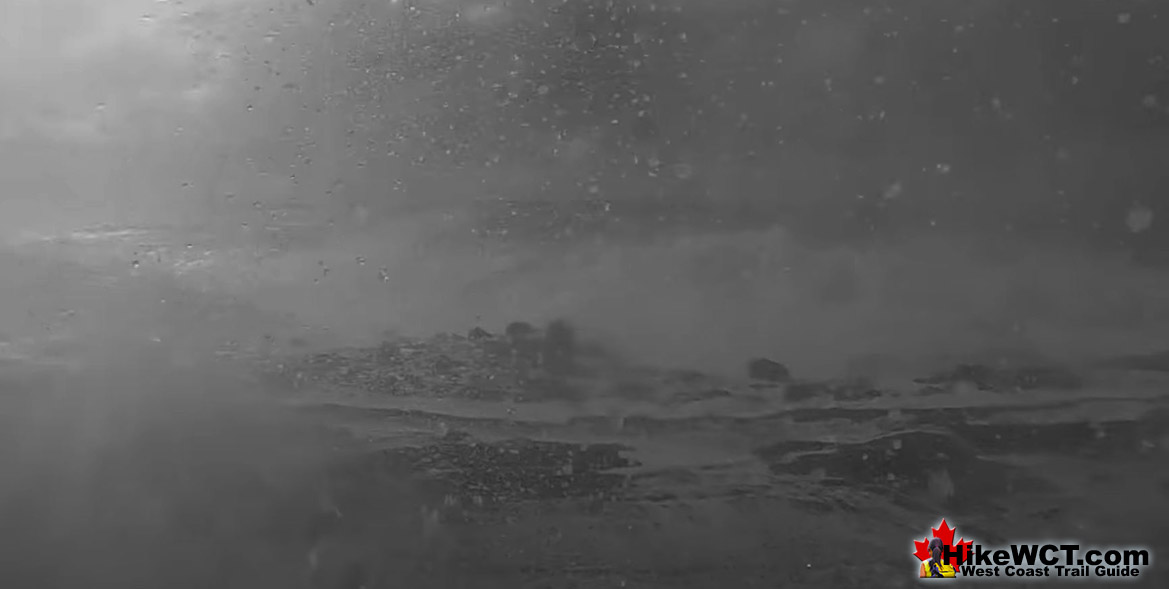
The coast south of Cape Flattery was, and still is considerably more accessible by land. The West Coast of Vancouver Island on the other hand, in 1906 was astoundingly remote and inaccessible by land. They assumed that they could find help fairly quickly. They had no way of knowing that there was almost no possibility of reaching help along this stretch of uninhabited coast. They were effectively on their own, help from the outside world was almost impossible to reach. Unfortunately, they had no idea how isolated and far from help they were.
Frank Bunker Leads the Party
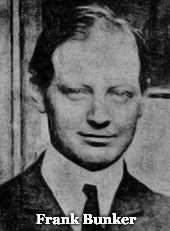 One of the nine survivors, passenger Frank Bunker figured prominently in leading this group from the start and they would later be dubbed the Bunker Party. Frank Bunker recalled the events of that night vividly a few days later in an interview. “In the morning I found a place where by difficult climbing we could get up the bluff and get from the water into the bush. Then I found a man who had been thrown up on the rocks, with his face smashed and he was crazy, and had to abandon him. We thought to get into the interior and arouse the inhabitants and then get back to the bluff, be we found no inhabitants. We found a rude trail along the telegraph line. We were in doubt as to whether the Valencia had any means of shooting a line and whether she was near enough to reach the bluff. Our judgement said to follow the telegraph line to the first station and get help by land and sea and to then return over the trail to the bluff."
One of the nine survivors, passenger Frank Bunker figured prominently in leading this group from the start and they would later be dubbed the Bunker Party. Frank Bunker recalled the events of that night vividly a few days later in an interview. “In the morning I found a place where by difficult climbing we could get up the bluff and get from the water into the bush. Then I found a man who had been thrown up on the rocks, with his face smashed and he was crazy, and had to abandon him. We thought to get into the interior and arouse the inhabitants and then get back to the bluff, be we found no inhabitants. We found a rude trail along the telegraph line. We were in doubt as to whether the Valencia had any means of shooting a line and whether she was near enough to reach the bluff. Our judgement said to follow the telegraph line to the first station and get help by land and sea and to then return over the trail to the bluff."
The Bunker Party had no idea the distance they would have to hike through the very challenging terrain to reach help. In their battered, wet and freezing condition, finding the telegraph wire must have seemed like a miracle. Surely it would lead to civilization nearby. "I and the others with me followed the telegraph line for several miles, until we finally reached a telegraph lineman’s hut at the side of Darling Creek. The snow was ankle deep and it was difficult to walk on the logs, and it was dangerous crossing the slippery logs over the creeks. Two of the men were without shoes and one had his ankle sprained and badly swollen, causing him great pain.” This is a map of the possible route the Bunker Party took to Darling River. We have no way of knowing the actual route they took, or even the precise location they washed ashore. The route shown here follows the present day West Coast Trail except of course, the supposed route they took from the bottom of the cliff. It seems likely that they would have tried to exit the forest as quickly as possible and the old telegraph line tended to run from tree to tree along the beach when possible. So, this may be quite accurate. There was another lineman's hut at Tsocowis Creek near KM16.6, which they did not see. The reason they missed it may be that they exited the forest onto the beach after passing the hut.

1pm Tues, 23 Jan: Darling River
The Bunker Party had arrived at the Darling River lineman's hut in the afternoon on Tuesday, January 23rd. Bunker recalled in an interview a few days later. “In the telegraph hut we found a receiver in a box. There were no directions, but I got it fixed on the wire and succeeded in calling up Mrs. Logan at Clo-oose and when she called her husband, Lineman Logan, I notified him of the wreck and he telegraphed to Lightkeeper Paterson at Cape Beale who gave the news to the world.” Bunker remembered it was somewhere around 1pm Tuesday, January 23rd when he spoke to Mrs. Paterson of the Cape Beale Lighthouse. This was thirteen hours after the Valencia wrecked and the first the world would learn of the disaster. Bunker recalled that he tried to make her understand that there had been a wreck that a steamer had gone on the rocks. She called her husband, who said he knew where he was. He told him there were nine in his party and that there were 100 people on board the wreck. This is when the Bunker Party first learned they were on Vancouver Island and not along the coast south of Cape Flattery in the United States.
9:30am Wed, 24 Jan: Rescue Ships Arrive
After the Bunker Party notified the world about the Valencia Tuesday afternoon, it wasn’t until late Wednesday morning that rescue vessels found the Valencia. The Queen, accompanied by the Canadian salvage steamer Salvor and tugboat Czar, located the Valencia about 9:30am. The Queen, a large 300-foot vessel, similar to the Valencia with a 21-foot draft reported seeing survivors on the hurricane deck and in the rigging, but was unwilling to approach closer than a mile. Captain Cousins of the Queen blamed the rough seas and uncharted ocean depths along the coast for his actions. He left the task of approaching close to the Valencia to the Salvor and the Czar, which were small vessels that could navigate in shallow waters.
The Salvor approached closer, however still kept a considerable distance of about a half mile and reported only seeing her two masts and her derrick and no people. The Czar similarly approached and reported to both the Queen and Salvor that there were signals flying but whether any person was in the rigging it was impossible to say. Victoria Daily Times reporter on the Salvor, recalled the decision at that moment. “The Czar made another trip to the Queen and back to the Salvor, and it was decided by those on the Salvor that it would be impossible to save anyone from the wreck from the water as to attempt to send in a boat would have undoubtedly resulted in the loss of a number of the rescuers. It was practically understood that the Queen would stand by the wreck and the Salvor and Czar would make for Bamfield Creek and send a party in over the trail.”
This disastrous decision to leave the scene of the Valencia and attempt a shore rescue probably cost the lives of many of the remaining 60-90 people barely clinging to life on the Valencia. The captains had to know that if they left now, they couldn’t possibly get a shore party to the Valencia in less than 20 hours. Which, they would soon find out, would take closer to 24 hours. Survivors on the Valencia very little time left before dying of exposure or the ship collapsing into the ocean. Whatever they thought, they decided to leave immediately. The time being about 10am, which tragically was about the time that the Valencia desperately, and surprisingly successfully, launched their remaining two life rafts, in the hope of reaching the now departing ships.
The Salvor and Czar arrived at Bamfield at about 12:30pm Wed 24th Jan. At about the same time they found out that the Valencia had collapsed into the sea and the remaining people on board drowned or were carried out to sea where the Salvor and Czar had recently departed. The shore party now focussed on hiking to the Bunker Party and departed from Bamfield later that afternoon along the estimated 15 mile route to reach them at Darling River.
3pm Wed, 24 Jan: McKay, Mousley and Richmond Arrive at Darling River
A party of three men from the cable station at Bamfield had started hiking to Darling River at 8am Wednesday morning after hearing the news of the wreck. Lineman McKay, Mousley and Richmond arrived at about 3pm and the beleaguered Bunker Party rushed to them with open arms. The small amount of food they managed to bring with them was passed around to the battered men, who Richmond described as looking like castaways.
4pm Wed, 24 Jan: Logan Party Arrives at Darling River
Lineman David Logan from Cloo-oose, Phil Daykin from the Carmanah Lighthouse and another man Joe Martin had begun hiking to the Valencia as soon as they heard the news from Bunker. The distance they had to cover through very difficult terrain was 16 kilometres. Much of the time they were in the dark and with sleet and rain falling and about 4 centimetres of snow on the ground. They had to navigate through knee deep mud, cross countless ravines and creeks. The creeks during winter become huge and fast, swollen by frequent, heavy rain.
They had reached the cliffs above the Valencia about an hour before it finally broke up. The only possible way they could help the ship is by receiving and fastening a rope fired by the ship with a Lyle gun. Unfortunately, all the lines had been fired from the Valencia hours ago and had chafed along the cliffs and had snapped. They watched helplessly as the ship broke up and the remaining survivors drowned or were pulled out to sea with the current where no ships remained. The three men then headed for Darling River, arriving there at 4pm Wednesday.
Though the Bunker Party had crossed Darling River the day before, heavy rain since then had caused it to be impossible to cross. R.P. Dunn, reporter for the Victoria Daily Times reported, “The only means to cross had been washed away and the operators from the cable station made an attempt which almost resulted in another tragedy. A wire was fastened round Mousley and the men lined behind him, each holding the wire and separated. Mousley went into the river, with Lineman McKay twenty feet behind. The first man was swept off his feet and was dashed back to the side from which he started. He was pulled ashore by his companions.”
9am Thurs, 25 Jan: Bunker Crosses Darling River
Thursday morning the Bunker Party also tried to cross Darling River to the Logan party on the other side. R.P. Dunn interviewed the Bunker Party a few days later. “But found it so swollen with the rains that such an attempt would be fraught with considerable danger. Nevertheless, they made several futile efforts, their endeavors being stimulated by Logan and Daykin, who were on the other side, having come from Clo-oose to render every assistance in their power. Everybody knows how important they were and how they were placed in the heartrending position of being forced to stand helplessly by and witness a hundred or more human beings carried to their doom by the waves that smashed the hull of the ship.”
Frank Bunker was determined to cross as he was desperately trying to find his wife and children that were drowned the first night. Dunn reported, “Bunker had crossed Thursday morning by going to the outlet of the river and entering the surf, again risking his life that had been in so much danger before in reaching shore from the wreck. The tide was running in and the daring man was washed off his feet and carried out in the breakers. Time and again he was washed ashore, each time closer to his destination, and at last, in an exhausted state he reached the side nearest the wreck and crawled out. When Mr. Bunker, rendered frantic, succeeded in swimming the stream, although almost being swept to sea in the attempt, his services and those of the others who succeeded in getting across were of no avail. He joined Logan’s party and walked along the beach towards the wrecks, returning at noon.”
1pm Thurs, 25 Jan: Bunker, Logan, Daykin Cross Darling River
Thursday afternoon the water in Darling River had fallen. In the afternoon the tide went out and Bunker, Logan, Daykin and Joe Martin crossed with difficulty. There is another lineman's hut located at Tsocowis Creek, 2.5km down the coast from Darling River.
11pm Thurs, 25 Jan: Ferris Shore Party Arrive
The shore party from the Salvor led by Captain Ferris arrived at Darling River at 11pm. They departed from Bamfield and hiked for fifteen miles through the trail to Darling River, which they later described as impassable. They brought some desperately needed food for the Bunker Party and planned to help them hike back out the next day. The shore party described the men in the Bunker Party at first sight in one clear sentence. “They were in a bad condition.” They began the long hike toward Pachena Bay and Bamfield in the morning.
3pm Fri, 26 Jan: Second Shore Party from the Salvor Reaches Pachena
R.P. Dunn, reporter for the Victoria Daily Times was part of a second shore party from the Salvor sent from Bamfield to further assist the Bunker Party to hike back out. “About 10am Jennings, Topping, Cox and myself set off over the trail upon our own little enterprise. We carried with us some provisions and a telephone instrument for connecting with the wire in case of obtaining any further news. After walking for two or three hours over well marked, but very difficult trail we reached Pachena hut. This is located upon a lovely sandy beach, fully a mile in length, upon which the immense waves boomed, dashing the spray well up towards the bank. At its extreme eastern end is the mouth of the Pachena River, ordinarily a small, insignificant stream, but then a large volume of water sweeping down from the mountains to the sea with great rapidity.”
Dunn’s description of the trail conditions from Bamfield to Pachena Bay is wonderfully detailed. “Before proceeding any further I would like to say something about that portion of the trail over which the nine survivors had to travel next day in order to reach Bamfield Creek. Superintendent McLaughlin, one of the cable staff informed me that the walk from his headquarters to the bay mentioned was a “carriage drive” compared to that piece – a stretch of about ten miles from Pachena to Darling River, where the sadly small party of survivors had gathered. It is only necessary for me to say that the part I went over was marked by innumerable bogs in which one was likely to sink thigh deep, in small pools coming over the knees and windfall trees, over which one was forced to climb, and to ask the reader to multiply these by three or four to enable the latter to obtain some idea of the difficulties the already worn out shipwrecked men had to surmount before reaching Bamfield Creek, to them a veritable haven of refuge. While on our way to Pachena we had to ford the river by means of a huge tree, which in one place was covered by at least fourteen inches of swirling water. We managed to get across without being swept off our feet, but later on had to creep through the bush a distance of a quarter of a mile to the beach, the trail proper being covered with water, it then being high tide. From this some conception of how badly an improvement in the trail along the coast is needed may be gathered.”
R.P. Dunn described the first sighting the Bunker Party. “The party was sighted at 3:10pm on a point of rock, having taken to the beach as the trail was too hard for the men to navigate in their famished condition. The Associated Press correspondent was the first to reach them. He found Frank Bunker, assistant superintendent of schools of Seattle, and Frank Richley on the beach in a bad condition, the latter having walked the whole way suffering from a sprained ankle and experiencing severe pain. Bunker had lost his coat and shirt and was wearing a blanket with arm holes cut in it.” A few minutes later more of the Bunker Party arrived. R.P. Dunn observed that, “All were completely fatigued. The entire party was equipped with shoes taken from corpses washed ashore.” In his discussions with the exhausted men, he found that Bunker was, “loudly praised by his fellows, he being a man of great vigor and bravery. When he reached Pachena he was clad only in his trousers and had his boots tied with a piece of string to hold them together. His shoulders were covered by a blanket, he having given his shirt to a fellow sufferer.”
3:30pm Fri, 26 Jan: Bunker Party Departs
Photo taken of the departure.
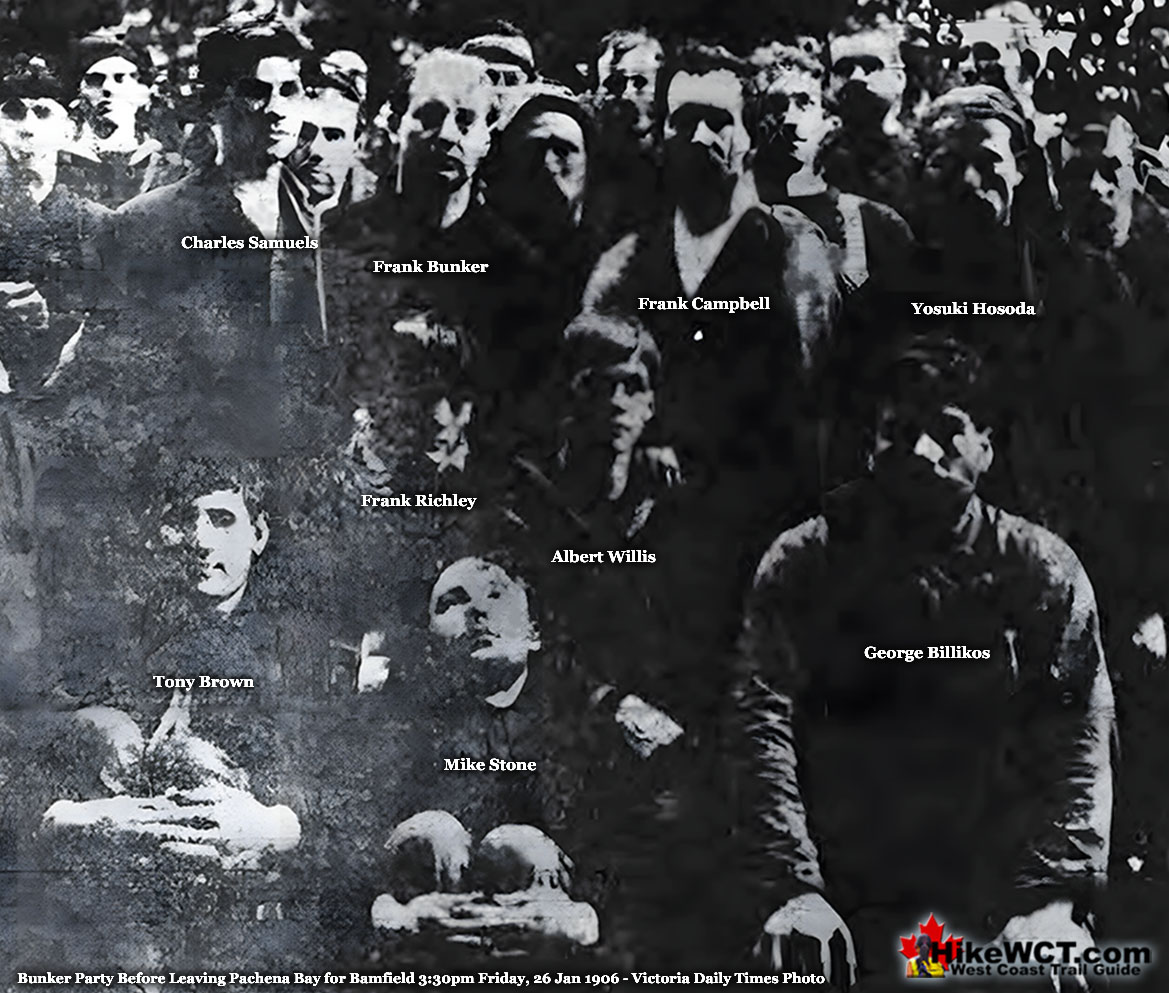
11pm Fri, 26 Jan: Bunker Party Arrives Bamfield
On Friday the Salvor’s party returned to Bamfield with the survivors, arriving at the station in the evening in an exhausted condition. The superintendent and his operators provided the men with everything necessary to make them comfortable.
8pm Sat, 27 Jan: Bunker Party Arrives in Seattle
Daily Colonist 28 reported that, "F.F. Bunker and the other survivors who made their way over the trail, suffering such hardships, were transferred to the United States revenue cutter Grant, after being succored by the Salvor’s crew."
Criticism of the Bunker Party
There were some questions after the Valencia disaster as to why the Bunker Party made no attempt to hike up to the cliff above the Valencia. Had they done so, they would have been able to receive a line fired from the ship with a Lyle line-firing gun, and use it to pull a heavy rope up and fasten it to a tree. This would have enabled the survivors on the Valencia to be hauled off the ship by a sort of pulley system. The common belief seems to be that they were so traumatized from surviving the boats and spending the night on the shore to have thought clearly enough to grasp this opportunity. The more probable explanation seems much more straightforward than that. First, how many passengers of a cruise ship would conceive of a ship having a Lyle line-firing gun that can fire 1500 feet with a line attached? It seems likely that the passengers in the group would not have known that. There were crew members in the group, though most did not speak English very well, so if they know of the Lyle gun, they did not convey the fact to the rest with any conviction. So believing that you would be helpless to do anything by reaching the cliffs above the Valencia, why would you bother? The second, and most hard to comprehend reason is that if they did know about the Lyle gun and were determined to hike to the cliff above the Valencia they would have to hike through the insane forest of the West Coast of Vancouver Island. In 1906, along what is today the West Coast Trail, was at that time an unmarked route through forest characterized as impenetrable. The difficulty of hiking through the forest at that time is nearly impossible to comprehend. A single kilometre could take hours to get through and with no trail to follow and surrounded by walls of forest, there is no way to know if the direction you are hiking leads anywhere. On top of that they just survived a brutal night, there was ankle deep snow along the coast and some of them had lost their shoes. They desperately hoped to contact the outside world to send help, and the best way to achieve this would be to follow the telegraph line they found in the direction of what they surely expected to be help nearby.
During the Valencia Inquiry in Seattle that took place following the disaster, George Billikos (often misspelled Beledhos, Belogous or B.E. Ledhos) and Frank Richley's testimonies appeared in the Victoria Daily Times on 2 February, 1906. George Billikos, a coal passer on the Valencia, his named always spelled wrong in newspapers. In this article he is "George Belogous, a Greek coal passer. who escaped from the wreck in the first boat launched from the vessel." He testified that Bunker appeared to be the leader of the party, and when he suggested that they return to the ship after the telephone line had been reached the latter replied: "No, I'm going to follow this telegraph line. I have lost my wife and two children, and now I am going to save my own life." Billikos continued, "I asked Mr. Bunker three or four times to turn back to the ship, but he refused, and he and the rest of his crew started off. I let them get about a quarter of a mile ahead of me, and then I got afraid and followed." Frank Richley, had a similar testimony, though contradicts Billikos by stating, "No one offered to stay." Which doesn't fit with Billikos asking three or four times to go to the ship and staying while the other departed until they were a quarter mile ahead. Richley had a sprained ankle and states this is why he stuck with the group.
Best West Coast Trail Sights & Highlights
The Valencia Disaster
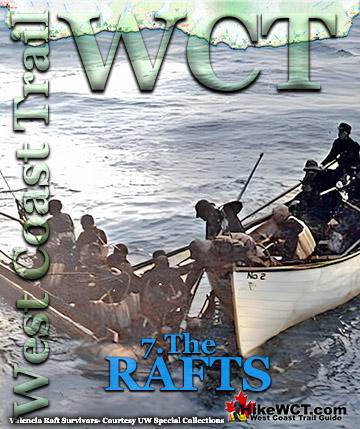
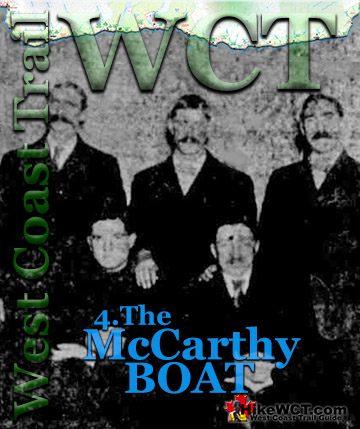
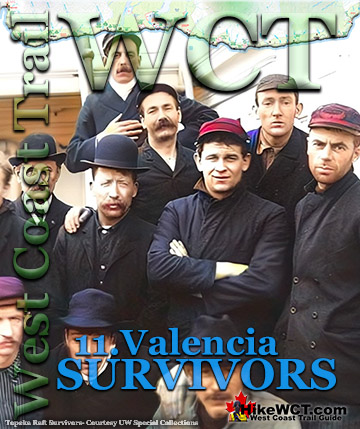

West Coast Trail A to Z
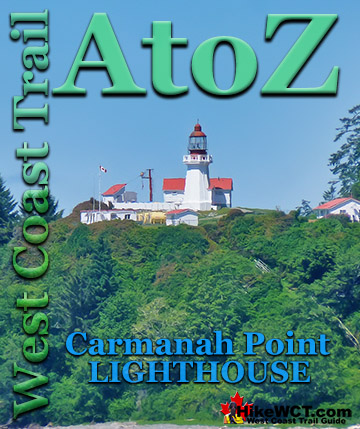

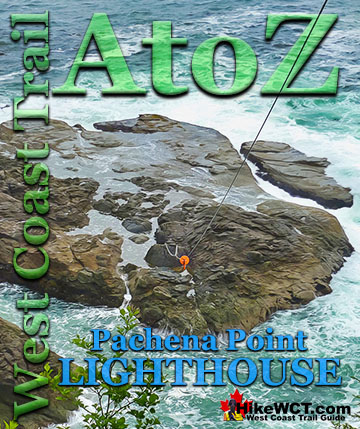

The West Coast Trail by Day
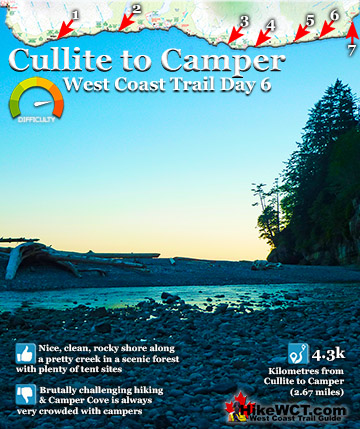
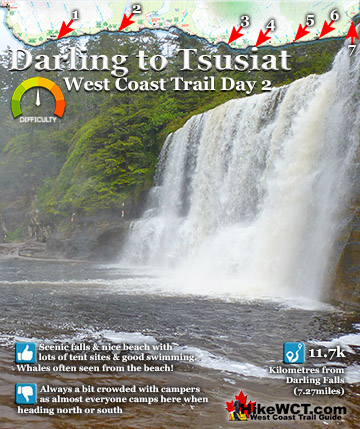
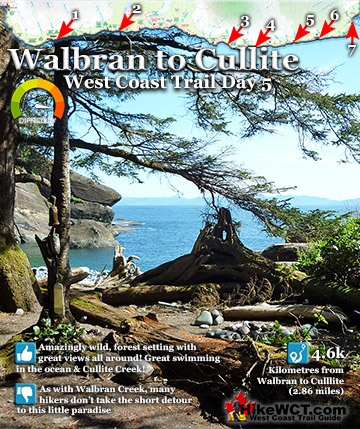
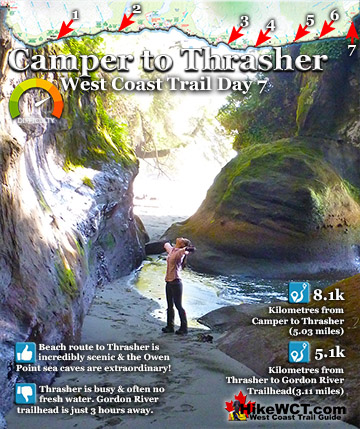
Explore BC Hiking Destinations!

The West Coast Trail

Victoria Hiking Trails

Clayoquot Hiking Trails

Whistler Hiking Trails
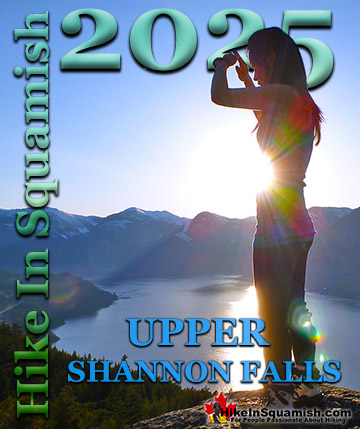
Squamish Hiking Trails

Vancouver Hiking Trails

